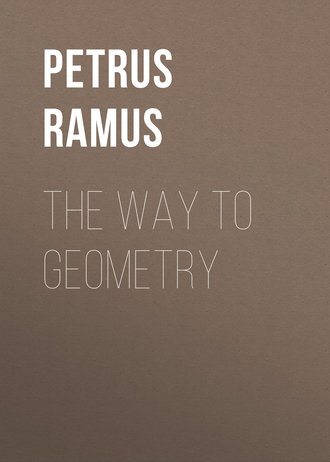 полная версия
полная версияThe Way To Geometry
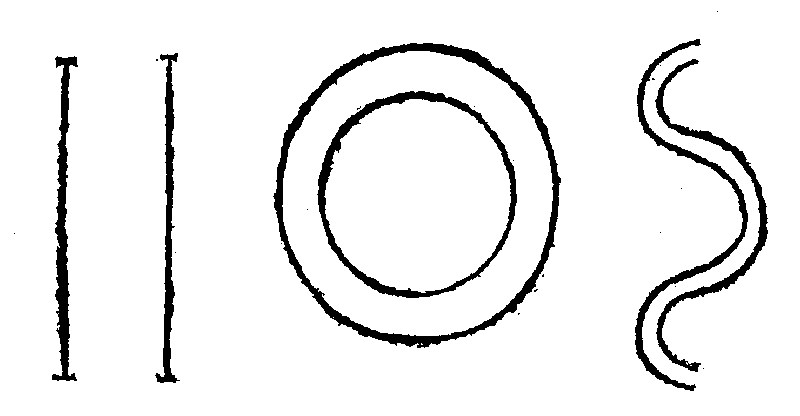
Parallell-equality is derived from perpendicularity, and is of neere affinity to it. Therefore Posidonius did define it by a common perpendicle or plum-line: yea and in deed our definition intimateth asmuch. Parallell-equality of bodies is no where mentioned in Euclides Elements: and yet they may also bee parallells, and are often used in the Optickes, Mechanickes, Painting and Architecture.
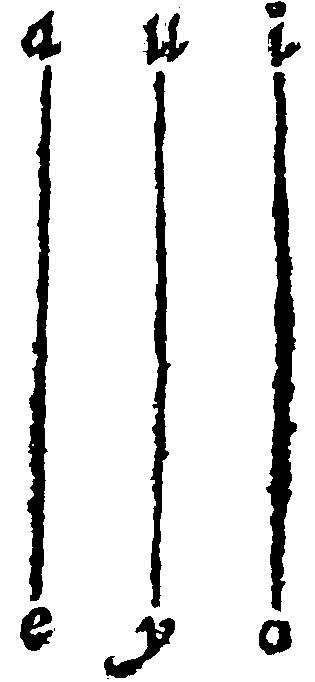
Therefore,
16. Lines which are parallell to one and the same line, are also parallell one to another.
This element is specially propounded and spoken of right lines onely, and is demonstrated at the 30. p. j. But by an addition of equall distances, an equall distance is knowne, as here.
The third Booke of Geometry. Of an Angle
1. A lineate is a Magnitude more then long.
A New forme of doctrine hath forced our Authour to use oft times new words, especially in dividing, that the logicall lawes and rules of more perfect division by a dichotomy, that is into two kindes, might bee held and observed. Therefore a Magnitude was divided into two kindes, to witt into a Line and a Lineate: And a Lineate is made the genus of a surface and a Body. Hitherto a Line, which of all bignesses is the first and most simple, hath been described: Now followeth a Lineate, the other kinde of magnitude opposed as you see to a line, followeth next in order. Lineatum therefore a Lineate, or Lineamentum, a Lineament, (as by the authority of our Authour himselfe, the learned Bernhard Salignacus, who was his Scholler, hath corrected it) is that Magnitude in which there are lines: Or which is made of lines, or as our Authour here, which is more then long: Therefore lines may be drawne in a surface, which is the proper soile or plots of lines; They may also be drawne in a body, as the Diameter in a Prisma: the axis in a spheare; and generally all lines falling from aloft: And therfore Proclus maketh some plaine, other solid lines. So Conicall lines, as the Ellipsis, Hyperbole, and Parabole, are called solid lines because they do arise from the cutting of a body.
2. To a Lineate belongeth an Angle and a Figure.
The common affections of a Magnitude were to be bounded, cutt, jointly measured, and adscribed: Then of a line to be right, crooked, touch'd, turn'd about, and wreathed: All which are in a lineate by meanes of a line. Now the common affections of a Lineate are to bee Angled and Figured. And surely an Angle and a figure in all Geometricall businesses doe fill almost both sides of the leafe. And therefore both of them are diligently to be considered.
3. An Angle is a lineate in the common section of the bounds.
So Angulus Superficiarius, a superficiall Angle, is a surface consisting in the common section of two lines: So angulus solidus, a solid angle, in the common section of three surfaces at the least.
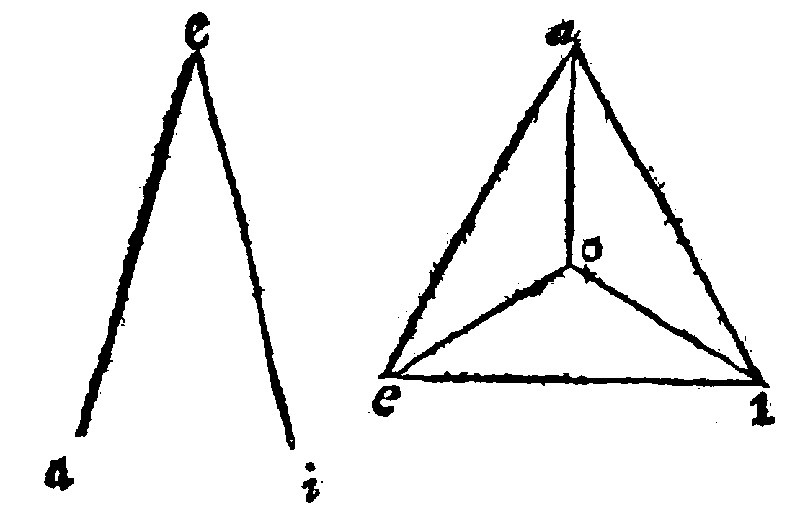
[But the learned B. Salignacus hath observed, that all angles doe not consist in the common section of the bounds, Because the touching of circles, either one another, or a rectilineal surface doth make an angle without any cutting of the bounds: And therefore he defineth it thus: Angulus est terminorum inter se invicem inclinantium concursus: An angle is the meeting of bounds, one leaning towards another.] So is aei. a superficiall angle: [And such also are the angles ouy. and bcd.] so is the angle o. a solid angle, to witt comprehended of the three surfaces aoi. ioe. and aoe. Neither may a surface, of 2. dimensions, be bounded with one right line: Nor a body, of three dimensions, bee bounded with two, at lest beeing plaine surfaces.
4. The shankes of an angle are the bounds compreding the angle.
Scèle or Crura, the Shankes, Legges, H. are the bounds insisting or standing upon the base of the angle, which in the Isosceles only or Equicrurall triangle are so named of Euclide, otherwise he nameth them Latera, sides. So in the examples aforesaid, ea. and ei. are the shankes of the superficiary angle e; And so are the three surfaces aoi. ieo. and aeo. the shankes of the said angle o. Therefore the shankes making the angle are either Lines or Surfaces: And the lineates formed or made into Angles, are either Surfaces or Bodies.
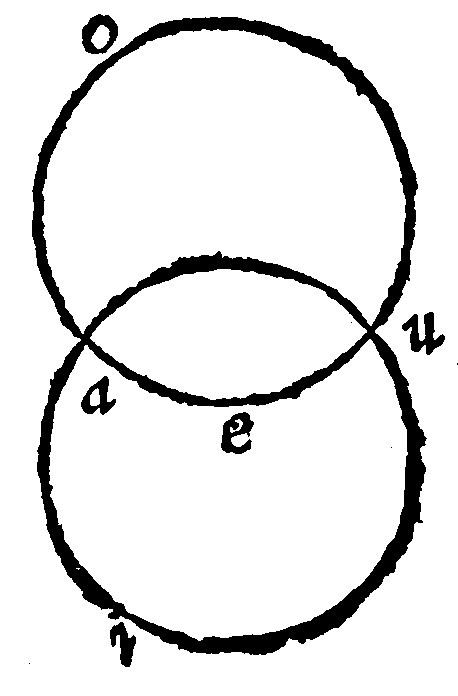
5. Angles homogeneall, are angles of the same kinde, both in respect of their shankes, as also in the maner of meeting of the same: [Heterogeneall, are those which differ one from another in one, or both these conditions.]
Therefore this Homogenia, or similitude of angles is twofolde, the first is of shanks; the other is of the manner of meeting of the shankes: so rectilineall right angles, are angles homogeneall betweene themselves. But right-lined right angles, and oblique-lined right angles between themselves, are heterogenealls. So are neither all obtusangles compared to all obtusangles: Nor all acutangles, to all acutangles, homogenealls, except both these conditions doe concurre, to witt the similitude both of shanke and manner of meeting. Lunularis, a Lunular, or Moonlike corner angle is homogeneall to a Systroides and Pelecoides, Hatchet formelike, in shankes: For each of these are comprehended of peripheries: The Lunular of one convexe; the other concave; as iue. The Systroides of both convex, as iao. The Pelecoides of both concave, as eau. And yet a lunular, in respect of the meeting of the shankes is both to the Systroides and Pelecoides heterogeneall: And therefore it is absolutely heterogeneall to it.
6. Angels congruall in shankes are equall.
This is drawne out of the 10. e j. For if twice two shanks doe agree, they are not foure, but two shankes, neither are they two equall angles, but one angle. And this is that which Proclus speaketh of, at the 4. p j. when hee saith, that a right lined angle is equall to a right lined angle, when one of the shankes of the one put upon one of the shankes of the other, the other two doe agree: when that other shanke fall without, the angle of the out-falling shanke is the greater: when it falleth within, it is lesser: For there is comprehendeth; here it is comprehended.
Notwithstanding although congruall or agreeable angles be equall: yet are not congruity and equality reciprocall or convertible: For a Lunular may bee equall to a right lined right angle, as here thou seest: For the angles of equall semicircles ieo. and aeu. are equall, as application doth shew. The angle aeo. is common both to the right angle aei. and to the lunar aueo. Let therefore the equall angle aeo. bee added to both: the right angle aei. shall be equall to the Lunular aueo.
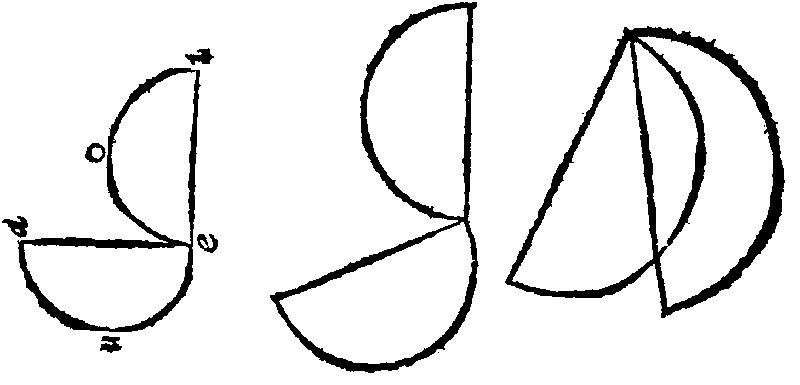
The same Lunular also may bee equall to an obtusangle and Acutangle, as the same argument will demonstrate.
Therefore,
7. If an angle being equicrurall to an other angle, be also equall to it in base, it is equall: And if an angle having equall shankes with another, bee equall to it in the angle, it is also equall to it in the base. è 8. & 4. p j.
For such angles shall be congruall or agreeable in shanks, and also congruall in bases. Angulus isosceles, or Angulus æquicrurus, is a triangle having equall shankes unto another.
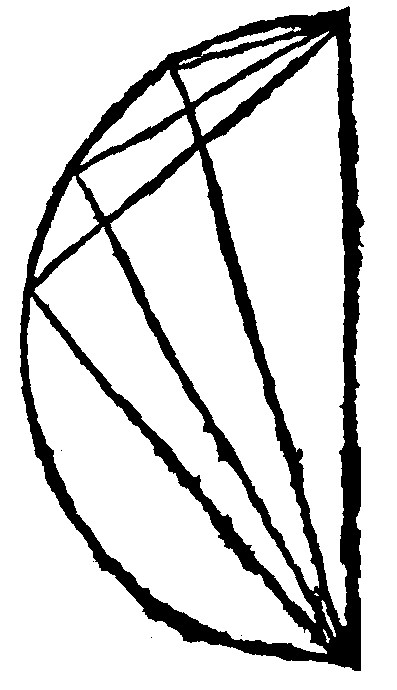
8. And if an angle equall in base to another, be also equall to it in shankes, it is equall to it.
For the congruency is the same: And yet if equall angles bee equall in base, they are not by and by equicrurall, as in the angles of the same section will appeare, as here. And so of two equalities, the first is reciprocall: The second is not. [And therefore is this Consectary, by the learned B. Salignacus, justly, according to the judgement of the worthy Rud. Snellius, here cancelled; or quite put out: For angles may be equall, although they bee unequall in shankes or in bases, as here, the angle a. is not greater then the angle o, although the angle o have both greater shankes and greater base then the angle a.]
And
9. If an angle equicrurall to another angle, be greater then it in base, it is greater: And if it be greater, it is greater in base: è 52 & 24. p j.
As here thou seest; [The angles eai. and uoy. are equicrurall, that is their shankes are equall one to another; But the base ei is greater then the base uy: Therefore the angle eai, is greater then the angle uoy. And contrary wise, they being equicrurall, and the angle eai. being greater then the angle uoy. The base ei. must needes be greater then the base uy.]
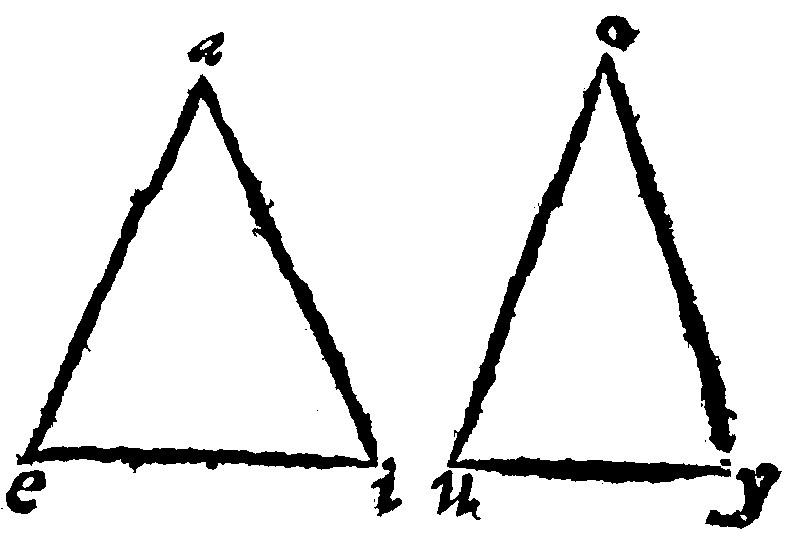
And
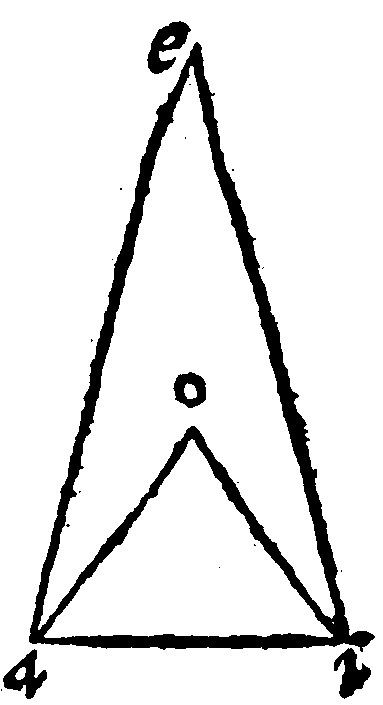
10. If an angle equall in base, be lesse in the inner shankes, it is greater.
Or as the learned Master T. Hood doth paraphrastically translate it. If being equall in the base, it bee lesser in the feete (the feete being conteined within the feete of the other angle) it is the greater angle. [That is, if one angle enscribed within another angle, be equall in base, the angle of the inscribed shall be greater then the angle of the circumscribed.]
As here the angle aoi. within the angle aei. And the bases are equall, to witt one and the same; Therefore aoi. the inner angle is greater then aei. the outter angle. Inner is added of necessity: For otherwise there will, in the section or cutting one of another, appeare a manifest errour. All these consectaries are drawne out of that same axiome of congruity, to witt out of the 10. e j. as Proclus doth plainely affirme and teach: It seemeth saith hee, that the equalities of shankes and bases, doth cause the equality of the verticall angles. For neither, if the bases be equall, doth the equality of the shankes leave the same or equall angles: But if the base bee lesser, the angle decreaseth: If greater, it increaseth. Neither if the bases bee equall, and the shankes unequall, doth the angle remaine the same: But when they are made lesse, it is increased: when they are made greater, it is diminished: For the contrary falleth out to the angles and shankes of the angles. For if thou shalt imagine the shankes to be in the same base thrust downeward, thou makest them lesse, but their angle greater: but if thou do againe conceive them to be pul'd up higher, thou makest them greater, but their angle lesser. For looke how much more neere they come one to another, so much farther off is the toppe removed from the base: wherefore you may boldly affirme, that the same base and equall shankes, doe define the equality of Angels. This Poclus,
Therefore,
11. If unto the shankes of an angle given, homogeneall shankes, from a point assigned, bee made equall upon an equall base, they shall comprehend an angle equall to the angle given. è 23. p j. & 26. p xj.
[This consectary teacheth how unto a point given, to make an angle equall to an Angle given. To the effecting and doing of each three things are required; First, that the shankes be homogeneall, that is in each place, either straight or crooked: Secondly, that the shankes bee made equall, that is of like or equall bignesse: Thirdly, that the bases be equall: which three conditions if they doe meete, it must needes be that both the angles shall bee equall: but if one of them be wanting, of necessity againe they must be unequall.]
This shall hereafter be declared and made plaine by many and sundry practises: and therefore here we bring no example of it.
12. An angle is either right or oblique.
Thus much of the Affections of an angle; the division into his kindes followeth. An angle is either Right or Oblique: as afore, at the 4 e ij. a line was right or straight, and oblique or crooked.

13. A right angle is an angle whose shankes are right (that is perpendicular) one unto another: An Oblique angle is contrary to this.
As here the angle aio. is a right angle, as is also oie. because the shanke oi. is right, that is, perpendicular to ae. [The instrument wherby they doe make triall which is a right angle, and which is oblique, that is greater or lesser then a right angle, is the square which carpenters and joyners do ordinarily use: For lengthes are tried, saith Vitruvius, by the Rular and Line: Heighths, by the Perpendicular or Plumbe: And Angles, by the square.] Contrariwise, an Oblique angle it is, when the one shanke standeth so upon another, that it inclineth, or leaneth more to one side, then it doth to the other: And one angle on the one side, is greater then that on the other.
Therefore,
14. All straight-shanked right angles are equall.
[That is, they are alike, and agreeable, or they doe fill the same place; as here are aio. and eio. And yet againe on the contrary: All straight shanked equall angles, are not right-angles.]
The axiomes of the equality of angles were three, as even now wee heard, one generall, and two Consectaries: Here moreover is there one speciall one of the equality of Right angles.
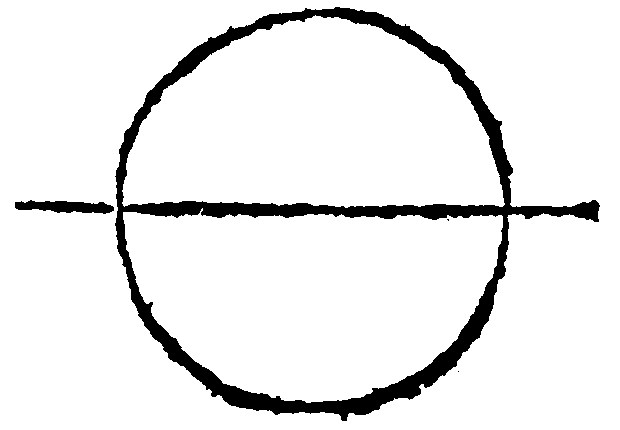
Angles therfore homogeneall and recticrurall, that is whose shankes are right, as are right lines, as plaine surfaces (For let us so take the word) are equall right angles. So are the above written rectilineall right angles equall: so are plaine solid right angles, as in a cube, equall. The axiome may therefore generally be spoken of solid angles, so they be recticruralls: Because all semicircular right angles are not equall to all semicircular right angles: As here, when the diameter is continued it is perpendicular, and maketh twice two angles, within and without, the outter equall betweene themselves, and inner equall betweene themselves: But the outer unequall to the inner: And the angle of a greater semicircle is greater, then the angle of a lesser. Neither is this affection any way reciprocall, That all equall angles should bee right angles. For oblique angles may bee equall betweene themselves: And an oblique angle may bee made equall to a right angle, as a Lunular to a rectilineall right angle, as was manifest, at the 6 e.
The definition of an oblique is understood by the obliquity of the shankes: whereupon also it appeareth; That an oblique angle is unequall to an homogeneall right angle: Neither indeed may oblique angles be made equall by any lawe or rule: Because obliquity may infinitly bee both increased and diminished.
15. An oblique angle is either Obtuse or Acute.
One difference of Obliquity wee had before at the 9 e ij. in a line, to witt of a periphery and an helix; Here there is another dichotomy of it into obtuse and acute: which difference is proper to angles, from whence it is translated or conferred upon other things and metaphorically used, as Ingenium obtusum, acutum; A dull, and quicke witte, and such like.
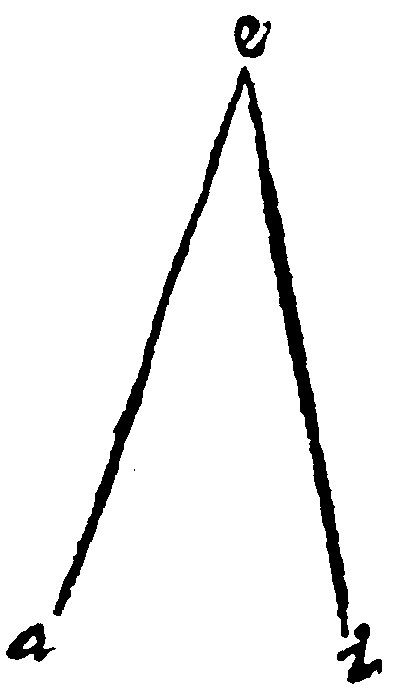
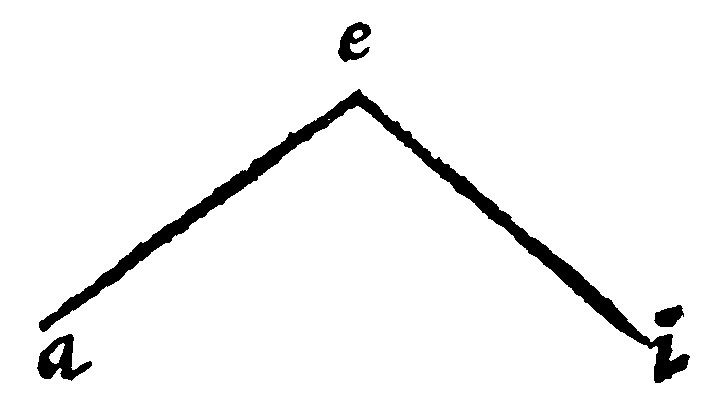
16. An obtuse angle is an oblique angle greater then a right angle. 11. d j.
Obtusus, Blunt or Dull; As here aei. In the definition the genus of both Species or kinds is to bee understood: For a right lined right angle is greater then a sphearicall right angle, and yet it is not an obtuse or blunt angle: And this greater inequality may infinitely be increased.
17. An acutangle is an oblique angle lesser then a right angle. 12. d j.
Acutus, Sharpe, Keene, as here aei. is. Here againe the same genus is to bee understood: because every angle which is lesse then any right angle is not an acute or sharp angle. For a semicircle and sphericall right angle, is lesse then a rectilineall right angle, and yet it is not an acute angle.
The fourth Booke, which is of a Figure
1. A figure is a lineate bounded on all parts.
So the triangle aei. is a figure; Because it is a plaine bounded on all parts with three sides. So a circle is a figure: Because it is a plaine every way bounded with one periphery.
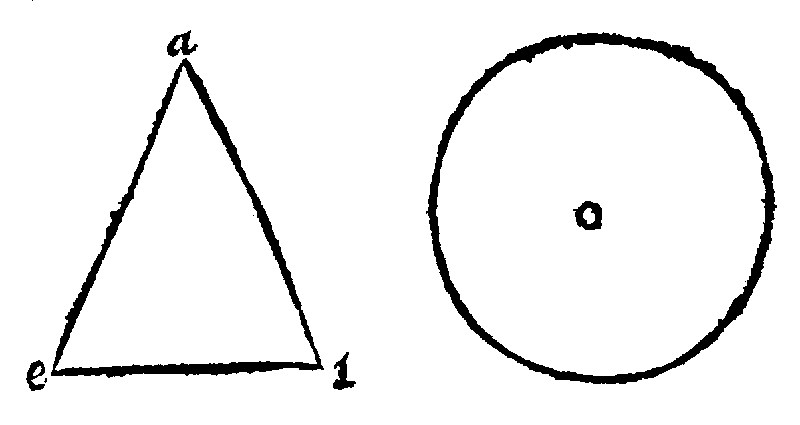
2. The center is the middle point in a figure.
In some part of a figure the Center, Perimeter, Radius, Diameter and Altitude are to be considered. The Center therefore is a point in the midst of the figure; so in the triangle, quadrate, and circle, the center is, aei.
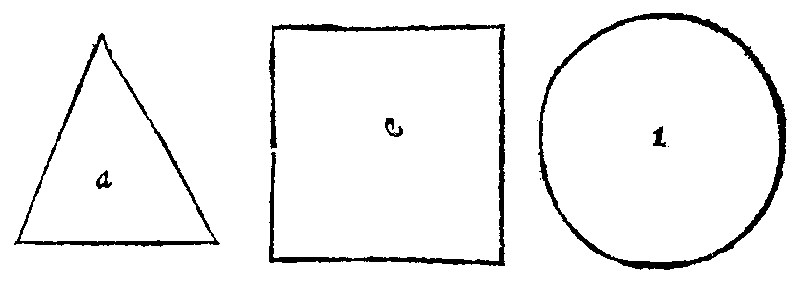
Centrum gravitatis, the center of weight, in every plaine magnitude is said to bee that, by the which it is handled or held up parallell to the horizon: Or it is that point whereby the weight being suspended doth rest, when it is caried. Therefore if any plate should in all places be alike heavie, the center of magnitude and weight would be one and the same.
3. The perimeter is the compasse of the figure.
Or, the perimeter is that which incloseth the figure. This definition is nothing else but the interpretation of the Greeke word. Therefore the perimeter of a Triangle is one line made or compounded of three lines. So the perimeter of the triangle a, is eio. So the perimeter of the circle a is a periphery, as in eio. So the perimeter of a Cube is a surface, compounded of sixe surfaces: And the perimeter of a spheare is one whole sphæricall surface, as hereafter shall appeare.
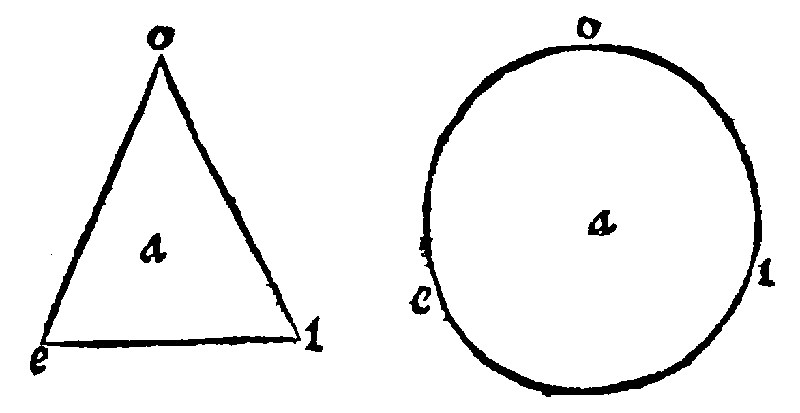
4. The Radius is a right line drawne from the center to the perimeter.
Radius, the Ray, Beame, or Spoake, as of the sunne, and cart wheele: As in the figures under written are ae, ai, ao. It is here taken for any distance from the center, whether they be equall or unequall.
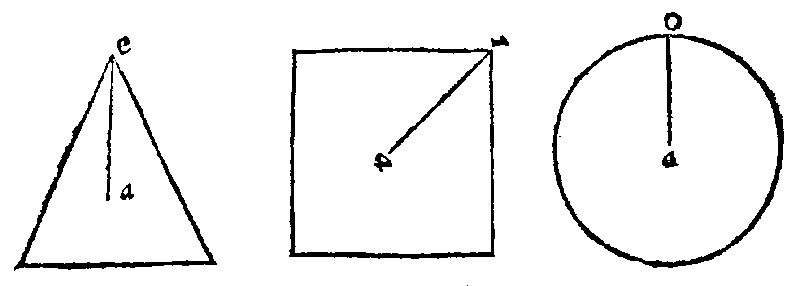
5. The Diameter is a right line inscribed within the figure by his center.
As in the figure underwritten are ae, ai, ao. It is called the Diagonius, when it passeth from corner to corner. In solids it is called the Axis, as hereafter we shall heare.
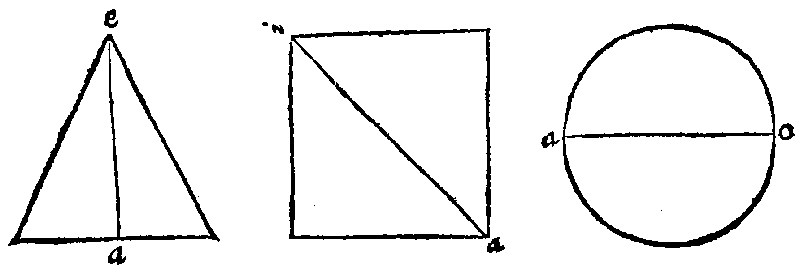
Therefore,
6. The diameters in the same figure are infinite.
Although of an infinite number of unequall lines that be only the diameter, which passeth by or through the center notwithstanding by the center there may be divers and sundry. In a circle the thing is most apparent: as in the Astrolabe the index may be put up and downe by all the points of the periphery. So in a speare and all rounds the thing is more easie to be conceived, where the diameters are equall: yet notwithstanding in other figures the thing is the same. Because the diameter is a right line inscribed by the center, whether from corner to corner, or side to side, the matter skilleth not. Therefore that there are in the same figure infinite diameters, it issueth out of the difinition of a diameter.
And
7. The center of the figure is in the diameter.
As here thou seest a, e, i this ariseth out of the definition of the diameter. For because the diameter is inscribed into the figure by the center: Therefore the Center of the figure must needes be in the diameter thereof: This is by Archimedes assumed especially at the 9, 10, 11, and 13 Theoreme of his Isorropicks, or Æquiponderants.
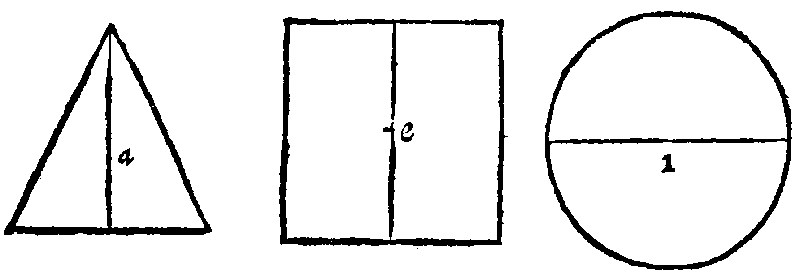
This consectary, saith the learned Rod. Snellius, is as it were a kinde of invention of the center. For where the diameters doe meete and cutt one another, there must the center needes bee. The cause of this is for that in every figure there is but one center only: And all the diameters, as before was said, must needes passe by that center.
And
8. It is in the meeting of the diameters.
As in the examples following. This also followeth out of the same definition of the diameter. For seeing that every diameter passeth by the center: The center must needes be common to all the diameters: and therefore it must also needs be in the meeting of them: Otherwise there should be divers centers of one and the same figure. This also doth the same Archimedes propound in the same words in the 8. and 12 theoremes of the same booke, speaking of Parallelogrammes and Triangles.

9. The Altitude is a perpendicular line falling from the toppe of the figure to the base.
Altitudo, the altitude, or heigth, or the depth: [For that, as hereafter shall bee taught, is but Altitudo versa, an heighth with the heeles upward.] As in the figures following are ae, io, uy, or sr. Neither is it any matter whether the base be the same with the figure, or be continued or drawne out longer, as in a blunt angled triangle, when the base is at the blunt corner, as here in the triangle, aei, is ao.

10. An ordinate figure, is a figure whose bounds are equall and angles equall.
In plaines the Equilater triangle is onely an ordinate figure, the rest are all inordinate: In quadrangles, the Quadrate is ordinate, all other of that sort are inordinate: In every sort of Multangles, or many cornered figures one may be an ordinate. In crooked lined figures the Circle is ordinate, because it is conteined with equall bounds, (one bound alwaies equall to it selfe being taken for infinite many,) because it is equiangled, seeing (although in deede there be in it no angle) the inclination notwithstanding is every where alike and equall, and as it were the angle of the perphery be alwaies alike unto it selfe: whereupon of Plato and Plutarch a circle is said to be Polygonia, a multangle; and of Aristotle Holegonia, a totangle, nothing else but one whole angle. In mingled-lined figures there is nothing that is ordinate: In solid bodies, and pyramids the Tetrahedrum is ordinate: Of Prismas, the Cube: of Polyhedrum's, three onely are ordinate, the octahedrum, the Dodecahedrum, and the Icosahedrum. In oblique-lined bodies, the spheare is concluded to be ordinate, by the same argument that a circle was made to bee ordinate.



